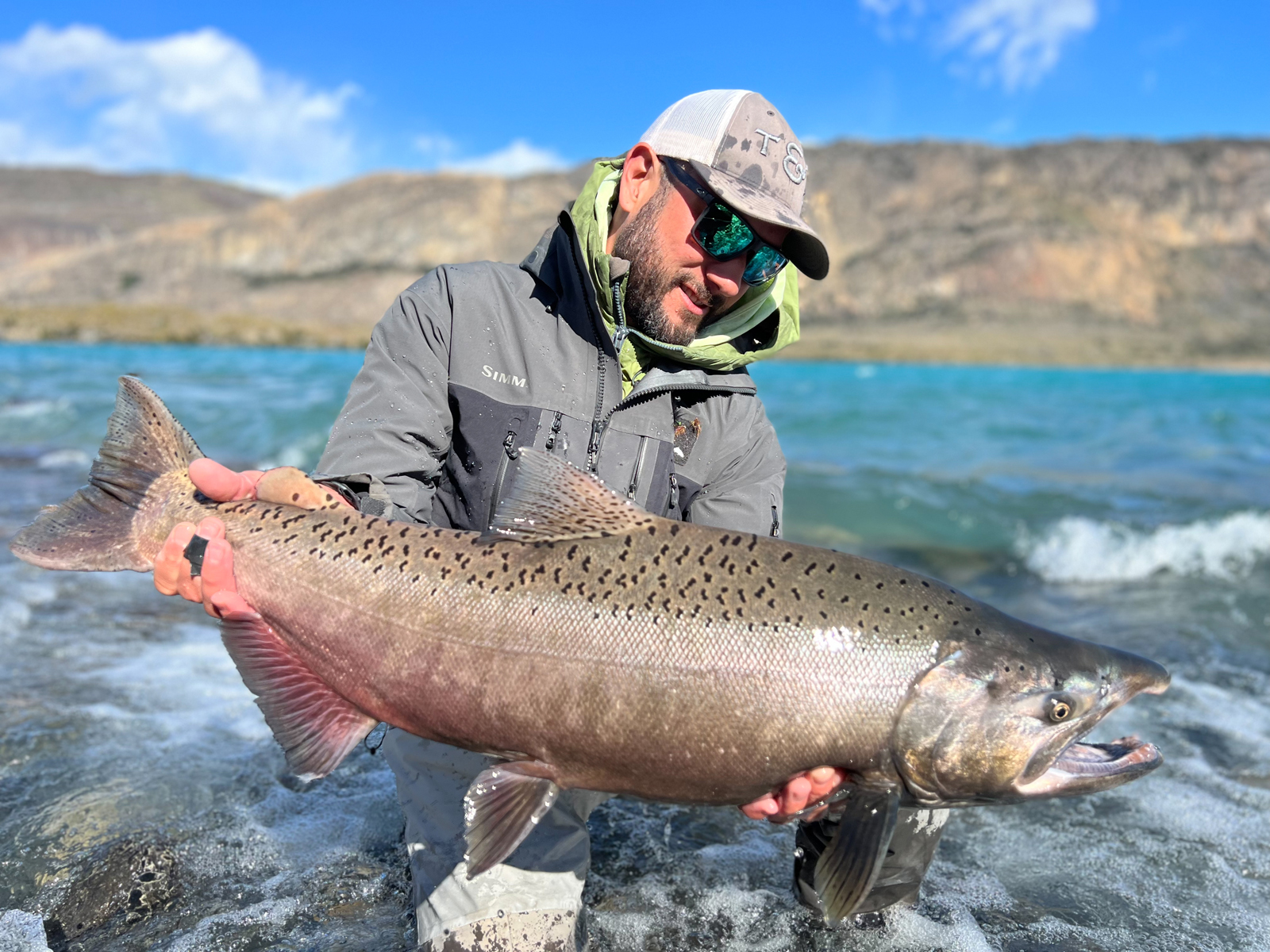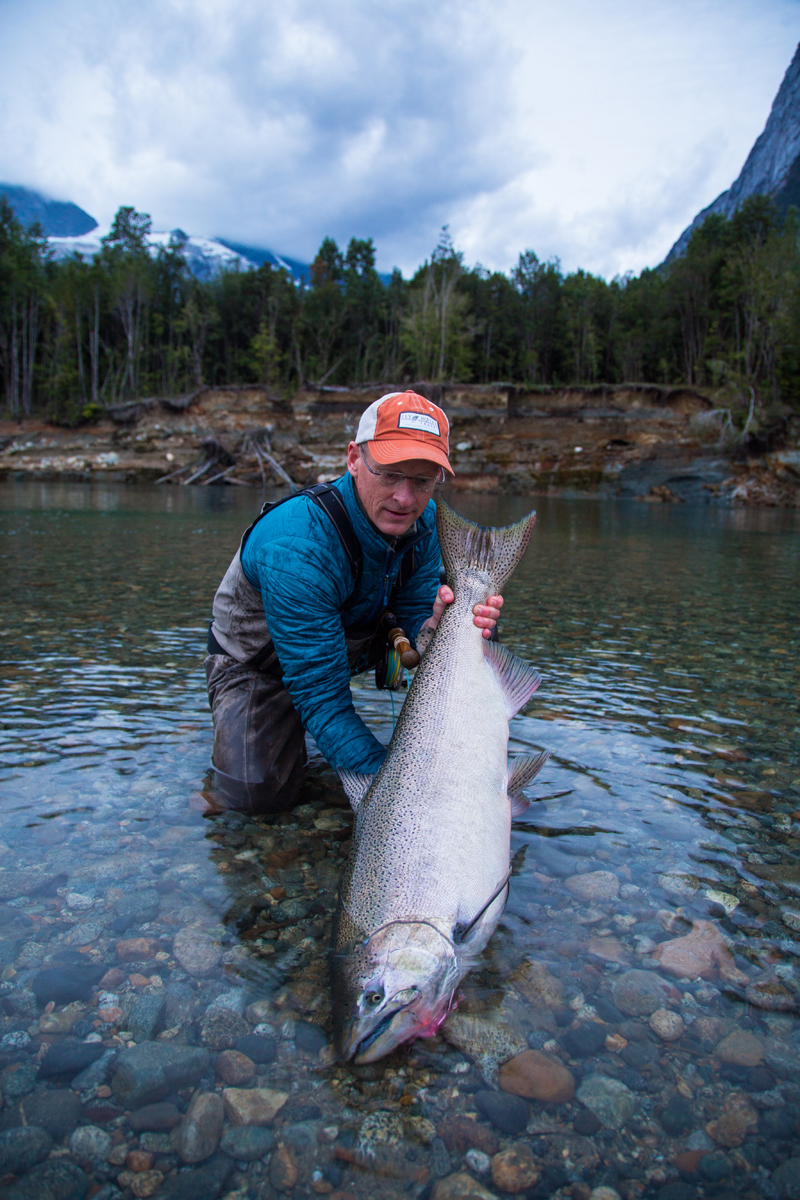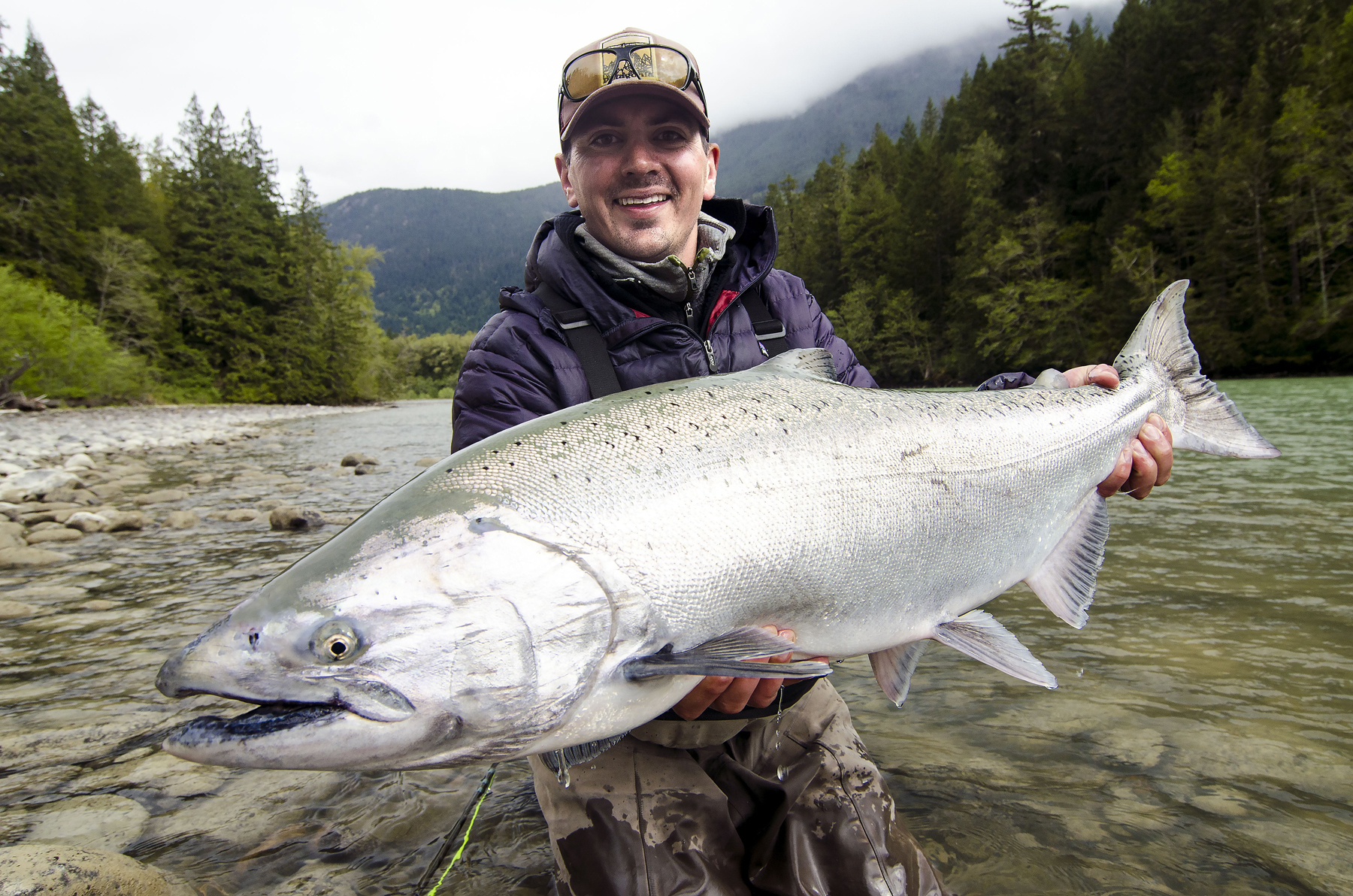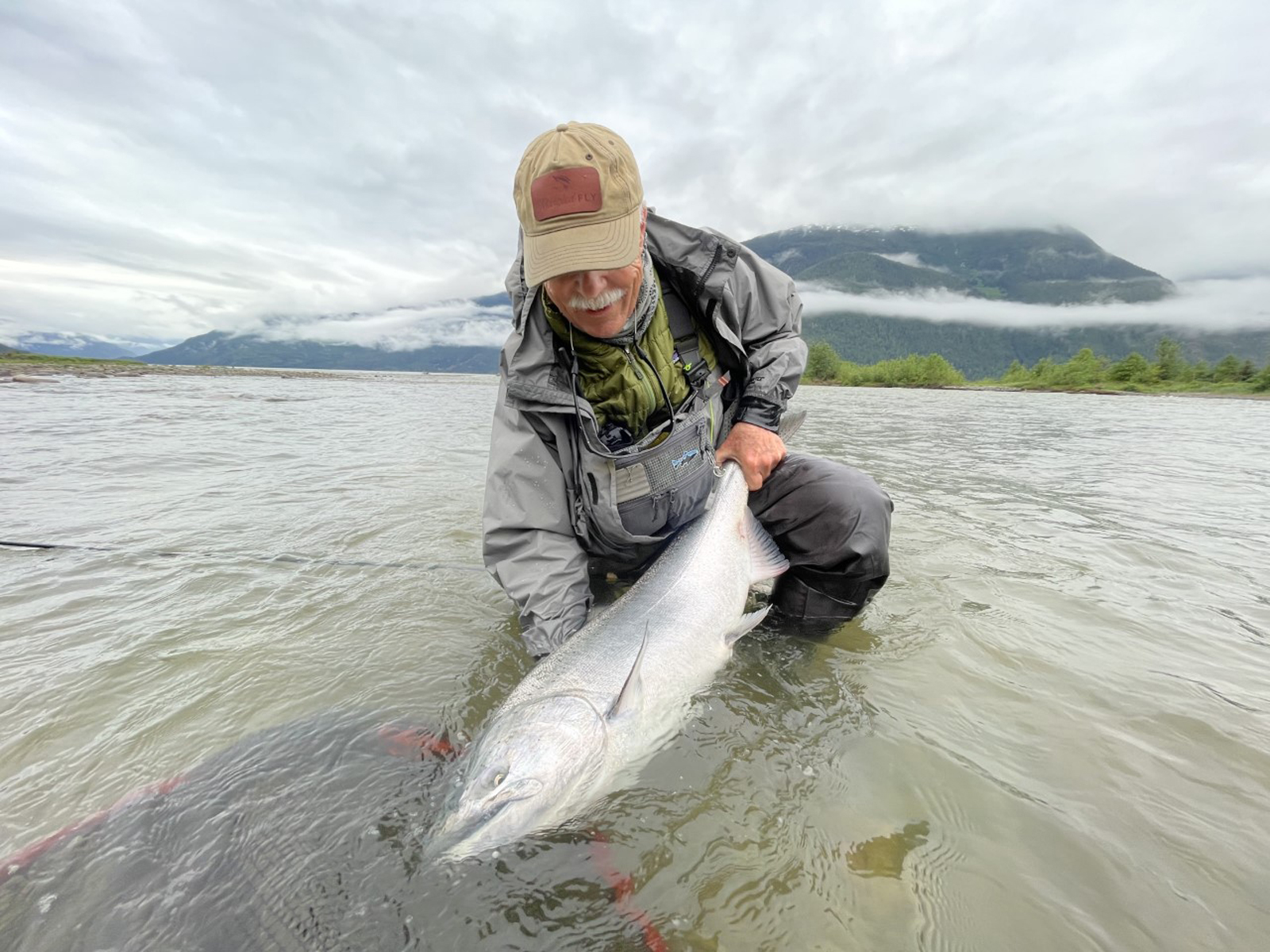
12 minute read
Where Kings Reign: A guide to the wide world of King salmon destinations
Whether you call it a King salmon, Chinook, Tyee, or Springer, Oncorhynchus tshawytscha is the largest, strongest, and for many, most sought after of the world’s salmon species. For Spey anglers in love with swinging flies, they have a special allure due to their well-deserved reputation of being the hardest fighting anadromous fish in the world. Even bringing one of these impressive specimens to hand represents a meaningful milestone in an angler’s journey.
By KEN MORRISH // Photos by KEN MORRISH and FRIENDS

King salmon are native to the northern Pacific Rim ranging from California to Alaska, as well as from northern Japan to northeast Siberia. With that said, they have also been introduced to several exotic locations outside of their historic range, including Chile, Argentina and the South Island of New Zealand. So, where exactly is the best place to target the aptly named King salmon? At Fly Water Travel, we are asked that often, and the answers will differ from angler to angler. To shed, more light on the subject the following will explore the best locations, their unique attributes, and the best time to plan your next King salmon trip.

Alaska
In many ways, Alaska is synonymous with King salmon. Many rivers support them, and while returns have been shaky by historic standards, it remains one of the best destinations for consistent King fishing. It is worth noting that Alaska does not necessarily offer the best opportunity for the largest specimens, but what it lacks in the sheer size of the fish it more than makes up for in the offering of river systems that are ideally suited to swinging flies.
“In many ways, Alaska is synonymous with King salmon”

The Kings in Alaska tend to be the “grabbiest” specimens in the world. Fish reaching a size of over 30 pounds are less common than they were two decades ago, but the chances of connecting with several fish a day in the 15-to 25-pound class remain excellent. In many ways these are ideal fish for fly anglers. They are fresh from the ocean, strong and can be targeted with an 8-weight Spey rigs and/or a 9-weight single hand rod. We break Alaskan King salmon fishing down into two distinct regions - Southwest Alaska and the Alaska Peninsula. The Peninsula is the long finger of land that extends southwest from Bristol Bay, then transitions at False Pass into the Aleutian Island chain.
It is wonderfully remote, sparsely populated, un-pressured and known for dynamic weather. On clear days you can see a dramatic backdrop of volcanic peaks where the northwesterly flowing rivers originate. Our two favorite rivers on the Peninsula are the Sandy and the Sapsuk. Both are moderate in size and ideally built to effectively cover with a fly. Both feature aggressive and bright fish that are best targeted from early June through mid-July.

Within the context of identifying great King fishing opportunities, I define the Southwest region as extending from the northern foot of the Alaska Peninsula in southern Bristol Bay, north to the Kuskokwim River. This vast area is home to many great lodges and interesting King salmon-laden rivers. The most famous of these King-centric systems is the Kanektok, a short distance south of the Kuskokwim. This river and the outfitters that guide it are largely responsible for popularizing fly fishing for Kings in Alaska. Likewise, the legendary Alaska West camp is largely responsible for the advent of Spey fishing for King salmon in the state.

The Kanektok is an ideal Spey casting river as it is large enough to present a challenge, but small enough to enable anglers to cover many of the most productive holding areas and traveling lanes. The region also features some expansive river systems that despite their formidable size offer great opportunities for Spey anglers. These include the Togiak, Nushagak, and Naknek rivers.

British Columbia
British Columbia offers ideal opportunities to target kings on the fly. The river systems we focus on include the Dean, Skeena, and the Kitimat. The Dean is best in June and the two miles of river beneath the falls represent one of the ultimate anadromous challenges in terms of landing a fish on foot. In the early season, the river tends to flow fast, and the sheer force of the current is impressive.
Landing a fish of even 20 pounds without the assistance of a boat is tough, as these fish typically peel out line and anglers are often deep into their backing before they know it. Some of the Dean King salmon exceed 30 pounds, and they are often simply too strong to land. I recommend the lodges on the lower river to anglers who really want to test their skills and to anglers who enjoy the process of being bested by fish of extraordinary strength.
“Some of the Dean King salmon exceed 30 pounds, and they are often simply too strong to land”

The Skeena region (especially the lower Skeena region around the town of Terrace) offers a truly world-class King fishery. The Skeena has undergone multiple King closures in the past years so anglers should view the area as a region and not expect to fish the main river, which could be closed or high and turbid when the run is peaking.
This region peaks from early June through mid-July but kings are available from late April well into August.

When targeting the Skeena region Kings, many of the outfitters will hop one system to the south to target the Kitimat River. It is perfectly suited for King fishing and fresh fish will push through the lower six miles of river every day. These are bright, large specimens and there is a real chance of hooking fish in excess of 35 pounds.
For the best shots at these fish our outfitting partners run an aggressive schedule, waking up well before dawn, driving 45 minutes, launching the rafts in the dark and then staking out a prime run before the first rays of sun hit the horizon. Typically, the most effective way to connect with these remarkable fish entails finding a run and fishing it continuously until new fish push through your staked-out area. If you are in the right place, doing the right thing at the right time, you stand a great chance of success. These operations are easy to reach, and represent excellent value as compared with some other venues. And to my eye, these are particularly handsome fish that really fight well.

Chile
If it were not for the distinct vegetation, it would be hard to differentiate the rugged granite-capped fjords of southern Chile’s Pacific coast from the coast of British Columbia. This was not lost on early visionaries who thought that Chile’s rivers might have the capacity to sustain wild returns of King salmon.
It was as though the geography of some of North America’s greatest salmon habitat was almost identically mirrored in South America. Starting in the late 19th century, multiple attempts were made to introduce Chinook to several major systems in Chile. These early attempts and many later attempts failed until the 1970s when Japanese “fish ranchers” sought to make their fortunes in the rivers and estuaries of Chile.

Between 1978 and 1989, they released hundreds of thousands of Chinook salmon smolts from the Columbia River’s Cowlitz hatchery, in hopes of them spawning naturally. While this commercial venture failed, the Chinook succeeded in adapting to the southern waters with a few spawning discreetly in the wild. At first, their foothold in the region was almost invisible but over time their numbers grew, and through the natural process of straying from their natal streams, they have now spread some 1800 kilometers south past the Strait of Magellan to Tierra del Fuego, colonizing a vast array of river systems in South America.
“Recently a new world record fish of 100 pounds was landed in Chile.”

Today there are many rivers in southern Chile with King salmon returns and recently a new world record fish of 100 pounds was landed in Chile. However, except for one truly special system, very few of the nation’s rivers are ideal for fly fishing. The lone stand-out is called Austral Kings, which features a beautiful, clear flowing river that enables fly anglers to fish for salmon close to the sea.
In my lengthy career fishing for King salmon, these fish are the most beautiful examples of the species I have ever encountered. Most of the fish are in the 20 to 40-pound class, but larger ones have been caught. The returns have varied over the past nine years with some strong seasons and some incredibly challenging seasons.
On years with high returns, there are many wade fishing opportunities ideal for Spey anglers, and on lower return years guests will spend more time fishing a limited number of pools from the boat. This place is absolutely stunning and perfectly suited to adventuresome anglers who are willing to make a considerable travel effort and enjoy rustic camps with incredible scenery and fish.

In my lengthy career fishing for King salmon, these fish are the most beautiful examples of the species I have ever encountered. Most of the fish are in the 20 to 40-pound class, but larger ones have been caught. The returns have varied over the past nine years with some strong seasons and some incredibly challenging seasons.
On years with high returns, there are many wade fishing opportunities ideal for Spey anglers, and on lower return years guests will spend more time fishing a limited number of pools from the boat. This place is absolutely stunning and perfectly suited to adventuresome anglers who are willing to make a considerable travel effort and enjoy rustic camps with incredible scenery and fish.
Argentina
Remarkably, the salmon that spread through southern Chile didn’t stop at the Straights of Magellan or the Pacific side of Tierra del Fuego. They simply kept going around the cape and took a crack at the Atlantic. Eventually they found the mouth of the massive Rio Santa Cruz. Here in southern Argentina, a consistent run of King salmon makes the 300-mile trek up the Santa Cruz River across Lago Argentino into a small tributary deep within Los Glaciers National Park. This fishery may become the home to the next world record salmon, where anglers consistently find fish in the 40 – 60lb range, and the current lodge record is held at a stout 93lbs.

Anglers will find the brightest fish from January into early February. The outfitters fish well into March as the fish move into their pre-spawn and spawning lies near the home base of their program at Estancia Cristina. During the early weeks, anglers focus their efforts on the rocky shore of the upper lake where the fish spend most of their time, as well as limited stretches of the Catarina River.
In the lake, fish are caught consistently by conventional fishing anglers and a few fortunate, hard-working anglers with Spey rods. But fishing the big wind-swept lake from shore with any form of fly rods is tough. Through late February and into March, the fish back down to the spawning grounds where they become more visible and are more effectively targeted by fly anglers. Given the long travel time, a surprising number of bright-ish Kings are available in the early weeks of the season, although the fish begin to color quickly as they move into the river. Anglers who have a strong preference for size over appearance enjoy this destination the most.
The King’s sheer size, tenacity, and raw beauty places it in the upper echelon of fish to add to your life list. The sudden pull of a mighty King broadside in a powerful current may be all-consuming and truly addictive once experienced. As we have seen there are a host of places where hearty anglers can test their wits with these fish and while it is often no easy task, the rewards of finding success are immeasurable. From the Aleutian Islands to the southern tip of South America, the kingdom is vast and varied, and we are here to help navigate the options, weigh the pros and cons and shepherd you through the process of preparing for the trip. For those anglers keen to swing flies with a Spey rod, your skills honed by the relentless pursuit of steelhead will serve you well. Give us a call, pack your gumption, and let us introduce you to a land where the Kings reign.
Feel free to email me directly at: Ken@flywatertravel.com. Browse King salmon destinations here: www.farbank.com/collections/flywater-travel-king-salmon-fly-fishing















